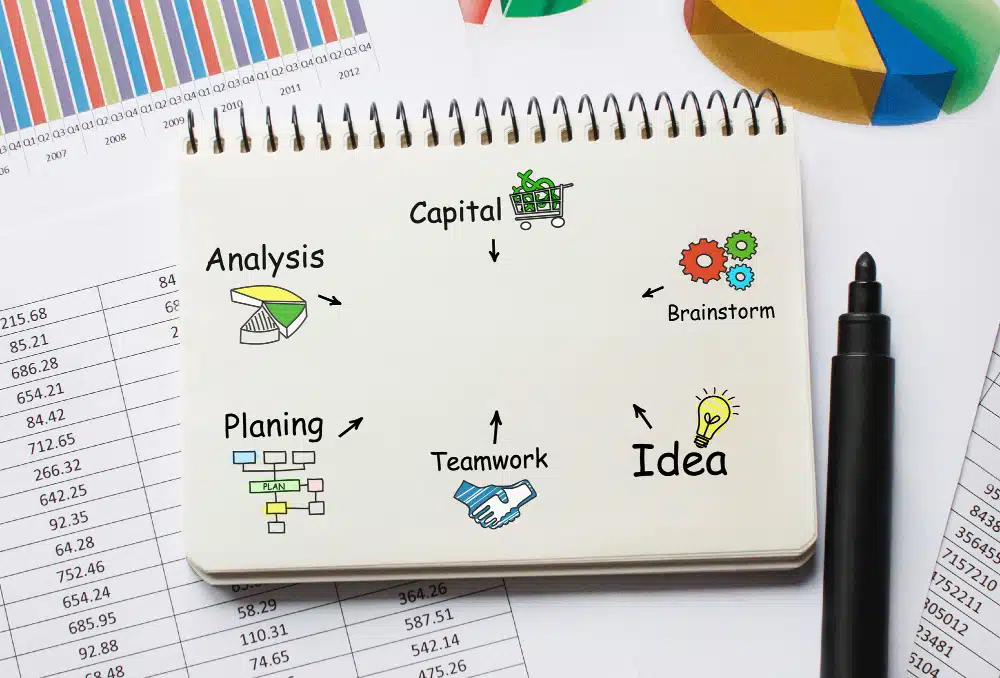Imagine you’re considering launching a new product line for your business. The decision involves a significant investment, and you need to be certain that it will be worth it. How can you determine if the potential benefits outweigh the costs? Enter cost benefit analysis (CBA) herein after shall be referred as CBA, a powerful tool that helps businesses make informed decisions by evaluating the financial feasibility and overall value of a project or decision.
Key Takeaways
-
Cost-Benefit Analysis is a systematic approach to evaluating the financial feasibility and overall value of a project, by computing expected returns and deducting costs.
-
Key components such as Direct Costs, Indirect Costs, Tangible Benefits, and Intangible Benefits must be considered for an accurate assessment.
-
Tools & techniques such as software & templates can help ensure successful CBA while avoiding common mistakes like overestimation of benefits or underestimation of costs.
Understanding Cost Benefit Analysis
Cost-benefit-analysis, also known as benefit cost analysis, is a systematic approach to evaluating the financial feasibility and overall value of a project or decision. It involves computing the expected returns from a situation or action and then deducting the overall costs associated with taking that action. The cost benefit analysis process assists businesses in becoming more data-driven and logical by offering tangible outcomes, particularly when benefits outweigh the costs. Cost benefits analysis, along with SWOT analysis, play a crucial role in this process.
The key components of CBA include:
-
Computing the expected returns from a situation or action
-
Deducting the overall costs associated with taking that action
-
Evaluating whether the benefits outweigh the costs
-
Assessing the financial feasibility and overall value of a project
The cost-benefit ratio, a key component of cost benefit analysis, refers to the mathematical correlation between the associated costs and financial returns of a project.
The precision of cost benefit analysis depends on the accuracy of the data inputted into the process, including accurate project costs. cost benefit analysis primarily aims to determine the prudence of embarking on a proposed project or task. Interestingly, the concept of cost-benefit analysis can be traced back to the 19th century, when a French engineer first utilized the technique to assess the costs and benefits associated with a water management project.
Key Components of Cost Benefit Analysis
To provide a comprehensive view of a project’s potential value, cost benefit analysis involves assessing four key components:
-
Direct costs
-
Indirect costs
-
Tangible benefits
-
Intangible benefits
These components allow decision-makers to consider all aspects of a decision, including financial and non-financial costs, as well as quantifiable and non-quantifiable benefits.
We will now explore these components in detail to understand their significance in cost benefit analysis.
Direct Costs
Direct costs are expenses directly tied to a project, such as:
-
Labor costs
-
Raw materials
-
Equipment costs
-
Transportation expenses
-
Fuel costs
Incorporating direct costs into a cost-benefit analysis enables a more precise evaluation of the financial consequences of a decision.
Consider, for instance, the expansion of a manufacturing facility. The direct costs would include the expenses of construction materials, additional machinery, and hiring new staff. A detailed analysis of these direct costs is fundamental in determining whether the potential return on investment justifies the expenditure.
Indirect Costs
Indirect costs, on the other hand, are expenses not directly linked to a project but still impact its overall cost, such as all the costs related to:
-
Accounting expenses
-
Litigation costs
-
Employee salaries
-
Office supplies
-
Office space rent
-
Security costs
-
Phone bills
Indirect costs are calculated using an indirect cost rate, which is the ratio between the total indirect costs and a direct cost base.
Incorporating indirect costs into cost benefit analysis ensures a more thorough and precise assessment of the entire costs involved, enabling a more informed assessment of the benefits and potential return on investment. For instance, in evaluating the financial impact of a marketing campaign, one should consider not only the direct advertising costs but also the indirect costs linked with staff time and resources dedicated to the campaign.
Tangible Benefits
Tangible benefits are quantifiable advantages of a project, such as increased revenue or reduced expenses. These expected benefits are calculated or estimated by considering factors such as cash flow, cash income, and cost reduction, and are expressed in dollar values to enable a valid comparison with costs.
For instance, the tangible benefits of launching a new product line could include increased sales revenue, cost savings from economies of scale, and enhanced market share. By quantifying these benefits and comparing them with the associated costs, decision-makers can determine whether pursuing the project is financially viable.
Intangible Benefits
Intangible benefits, in contrast, are non-quantifiable advantages of a project, such as improved customer satisfaction or enhanced brand reputation. These benefits are harder to measure and assign a monetary value, but they can still have a significant impact on a project’s success. Surveys, customer feedback, and other qualitative methods can be used to measure intangible benefits.
For example, implementing a new customer support system may not lead to immediate financial gains. However, the intangible benefits of improved customer satisfaction can lead to increased customer loyalty and positive word-of-mouth, ultimately resulting in long-term revenue growth. By considering both tangible and intangible benefits, decision-makers can evaluate a project’s overall value more accurately.
When to Use Cost Benefit Analysis
CBA is best suited for high-impact decisions with clear economic costs and benefits, such as projects, investments, policies, resource allocation, and organizational changes. It’s particularly beneficial when there are competing priorities for limited resources, as it helps decision-makers prioritize and allocate resources effectively. CBA is commonly employed in project management, business decision-making, and government investment decisions.
However, certain situations, like complex issues such as climate change, disputes over benefits or results, or when moral considerations take precedence, may not be suitable for CBA. In such cases, alternative decision-making tools and approaches may be more appropriate.
Step-by-Step Guide OR How to do a Cost Benefit Analysis
For a successful cost benefit analysis, the following steps should be followed:
-
Begin by establishing a framework that defines the scope, stakeholders, and objectives of the analysis.
-
Next, identify and categorize the direct costs, indirect costs, tangible benefits, and intangible benefits associated with the project or decision.
-
Assign monetary values to each cost and benefit, ensuring that the values are as accurate and realistic as possible.

Once the costs and benefits have been quantified, compare the results using key metrics such as net present value or benefit-cost ratio. Conduct a sensitivity analysis to evaluate different scenarios and their impact on the cost benefit analysis. This will help you understand how changes in variables could affect the outcome, ensuring that you make well-informed decisions.
Finally, document the results and present them to decision-makers in a clear and concise manner. This will enable them to understand the costs and benefits associated with different options and make informed decisions based on the data.
Analyzing the Results: Key Metrics and Considerations
In the analysis of CBA results, one should consider key metrics and potential influencing factors. Some important metrics to consider are:
-
Net present value (NPV): This is a crucial metric that incorporates an alternative rate of return that could be attained had the project not been executed.
-
Benefit-cost ratio: This is the mathematical correlation between the associated costs and financial returns of a project.
-
Sensitivity analysis: This is a valuable technique for evaluating the accuracy of outcomes with regards to a set of variables.
These metrics can provide valuable insights into the financial viability and potential impact of a project.
In addition to these key metrics, it’s crucial to consider factors such as the relevant time period, discount rates, and potential risks when analyzing cost benefit analysis results. By taking these factors into account, you can ensure that your analysis is comprehensive, accurate, and useful for decision-making.
Limitations and Challenges of Cost Benefit Analysis
Despite a multitude of advantages, CBA does come with its own set of limitations and challenges. Some of these include:
-
Difficulty in measuring intangible benefits, which can be subjective and hard to assign a monetary value
-
Subjective value assignment, which can introduce bias and uncertainty into the analysis, making it difficult to attain accurate and objective results
-
Complexity in conducting a precise CBA due to the inputs necessary, the requirement to establish parameters, and the expensive nature of the inputs
To overcome these limitations and challenges, it’s essential to approach CBA with a clear understanding of its purpose and limitations, and to use complementary decision-making tools and techniques when necessary. This will help ensure that your analysis is as accurate and reliable as possible, ultimately leading to better decision-making.
Real-World Examples of Cost Benefit Analysis
Various industries and scenarios have seen the application of CBA, demonstrating its practicality and effectiveness in decision-making. In the healthcare industry, CBA is used to assess the cost-effectiveness of different treatment options, analyze the financial impact of implementing new healthcare technologies, and estimate the economic benefits of preventive healthcare measures. In environmental projects, CBA is utilized to assess the economic viability and potential advantages of implementing certain policies or projects with environmental objectives.
While, in the education sector, a cost-benefit analysis example could involve appraising the financial costs and benefits of introducing a novel educational program or intervention. By quantifying and comparing the costs and benefits, decision-makers can make enlightened decisions that maximize the overall welfare and sustainability of the environment, the healthcare system, and educational institutions.
Tools and Techniques for Effective Cost Benefit Analysis
Various tools and methodologies can facilitate a successful CBA. Some examples include:
These software tools can help streamline the process and improve the accuracy of the analysis. Additionally, cost-benefit analysis templates are available to help organize and optimize the CBA process.
Forecasting techniques also play a crucial role in CBA by providing approximations of future costs and benefits. By incorporating forecasting into cost-benefit analysis, decision-makers can make more enlightened choices based on the anticipated returns and possible risks associated with different options.
Common Mistakes to Avoid in Cost Benefit Analysis
Avoiding common pitfalls such as overestimation of benefits, underestimation of estimated costs, and neglect of alternative options is crucial to ensure the accuracy and reliability of your CBA. Overestimating benefits can result in inaccurate and biased cost estimates, leading to financial losses and unrealistic expectations. Underestimating costs can impair the validity and reliability of the CBA, resulting in ill-conceived decisions.
By considering a range of alternatives and striving for precise and realistic estimates, you can minimize these risks and ensure that your CBA is as accurate and useful as possible. This will ultimately lead to better decision-making and more efficient utilization of resources.
Summary
In conclusion, cost-benefit analysis is a powerful tool that helps businesses make informed decisions coupled with SWOT analysis by evaluating the financial feasibility and overall value of a project or decision. By understanding the key components of CBA, knowing when to use it, and employing the right tools and techniques, you can ensure that your analysis is accurate, comprehensive, and useful for decision-making.
By avoiding common pitfalls and considering both tangible and intangible benefits, you can make the most of your CBA and ultimately drive better decision-making and resource allocation in your organization. We, at PMtech Digital Solutions, got you covered in this regard. If you’re looking to get the CBA & SWOT done, then, look no further and Contact Us today!







